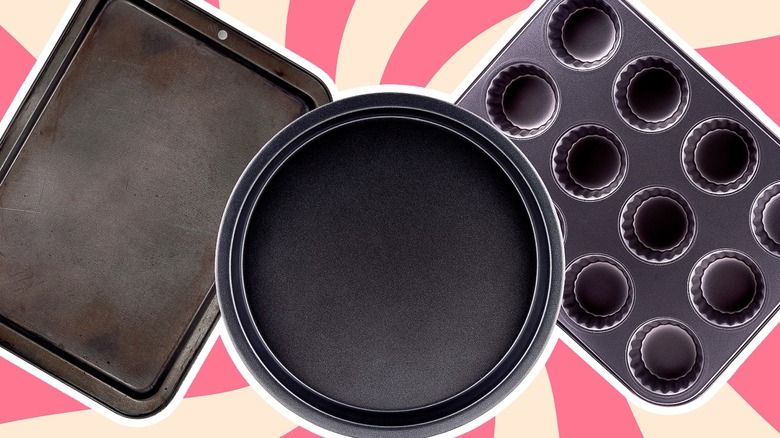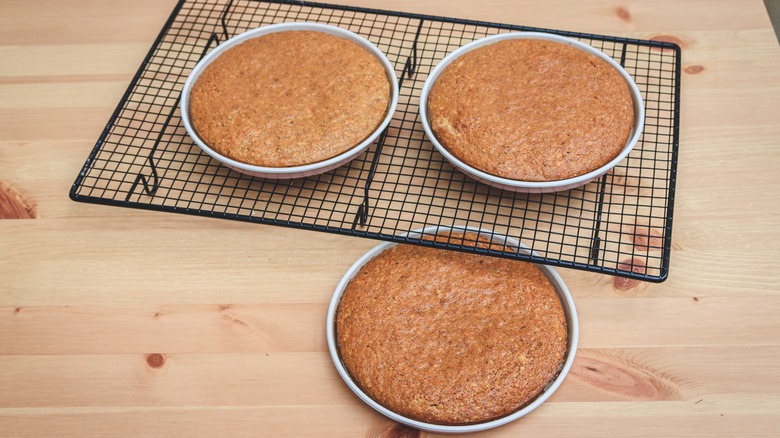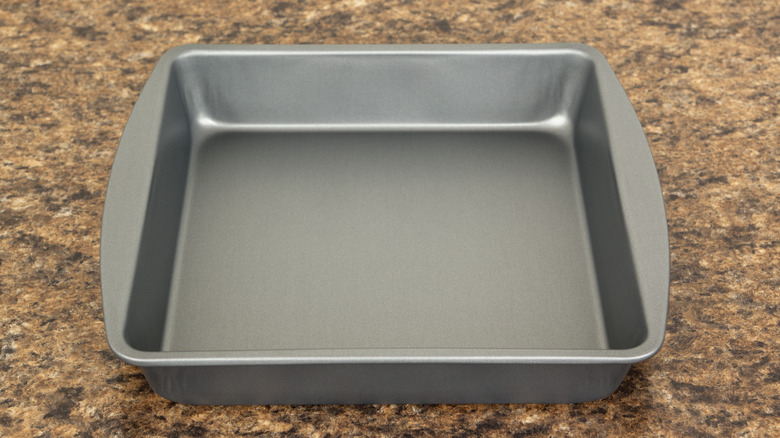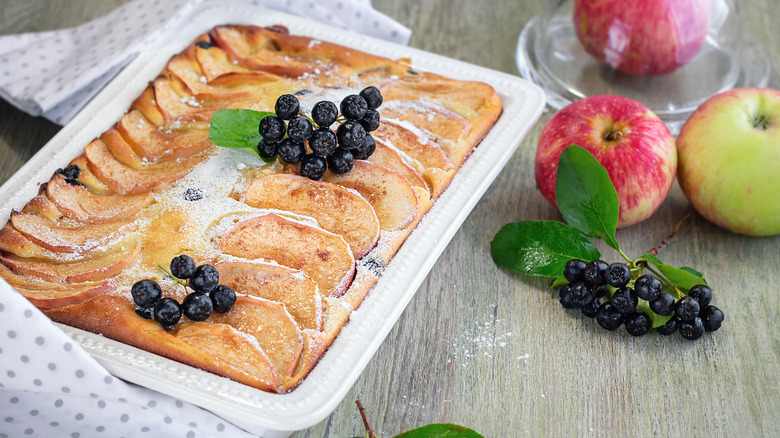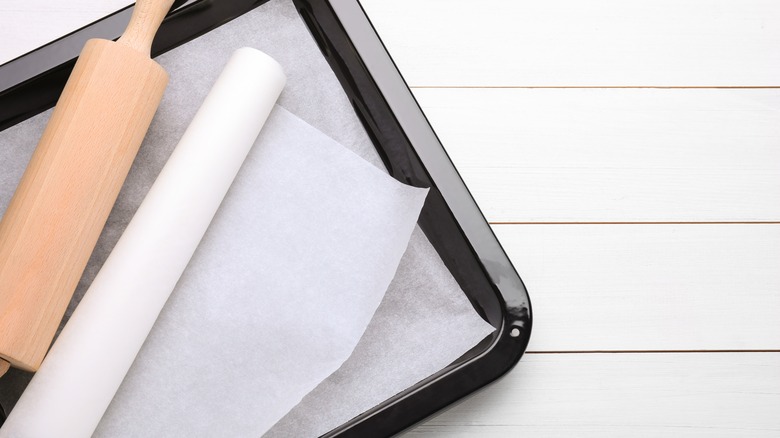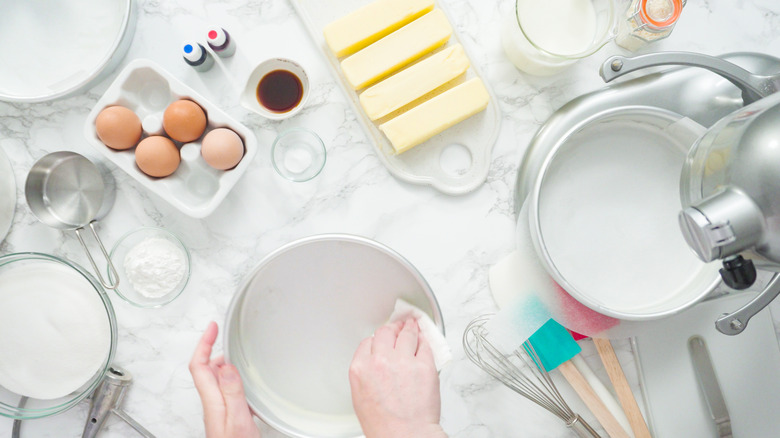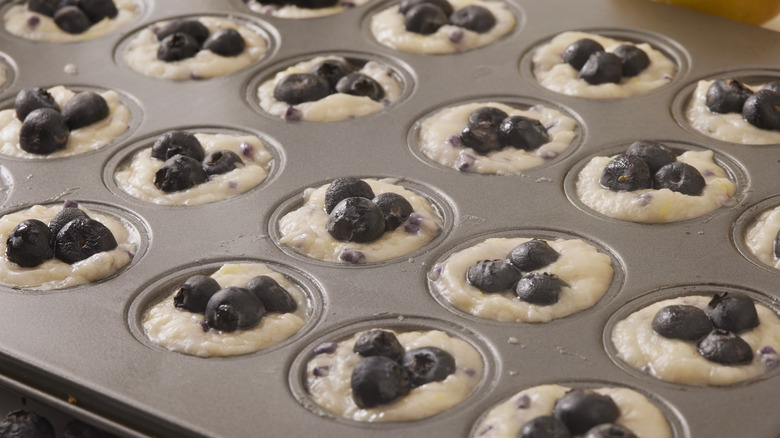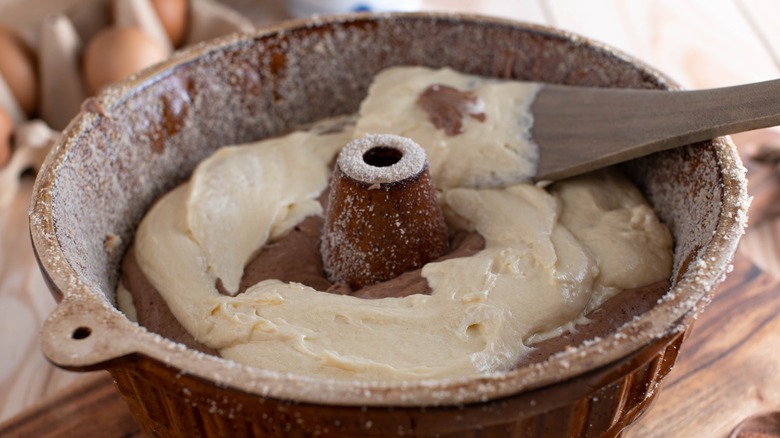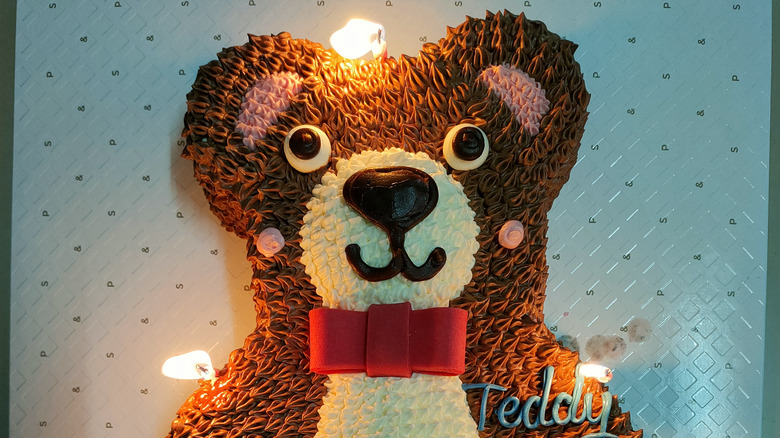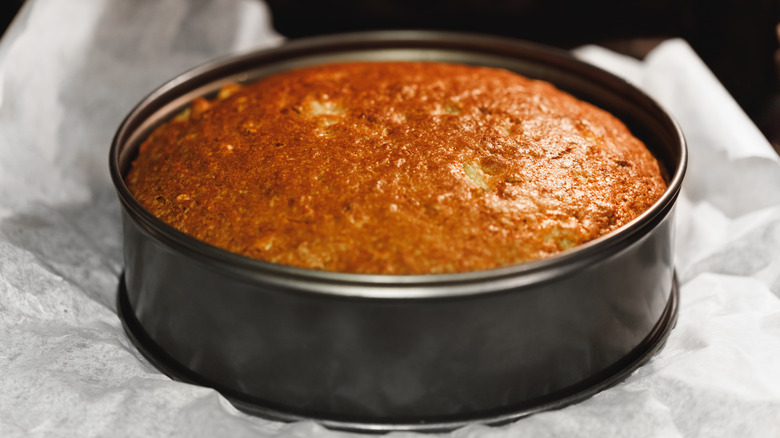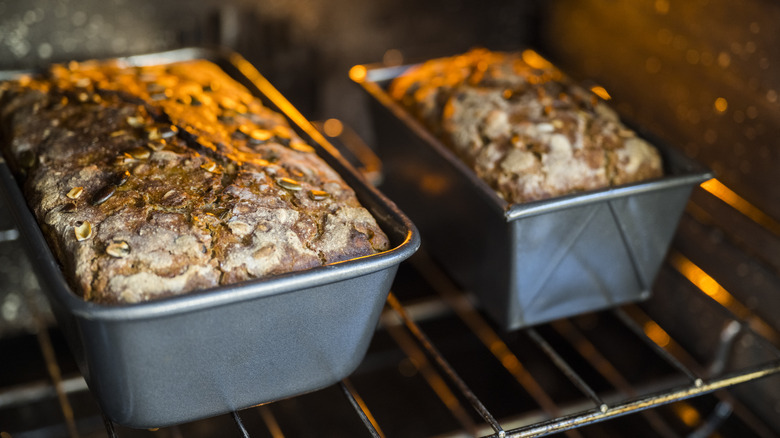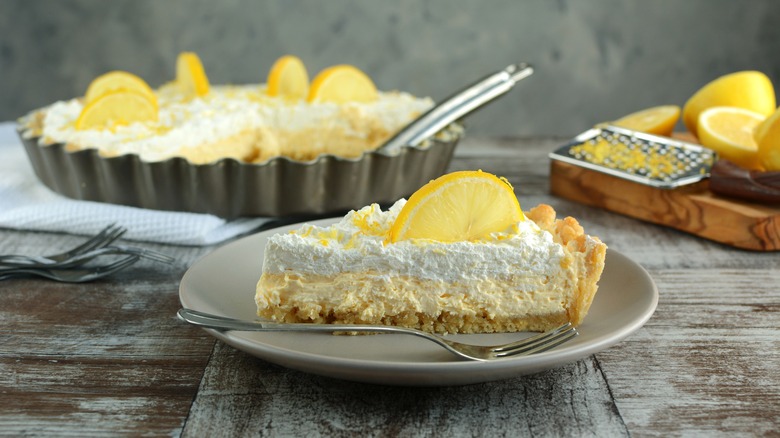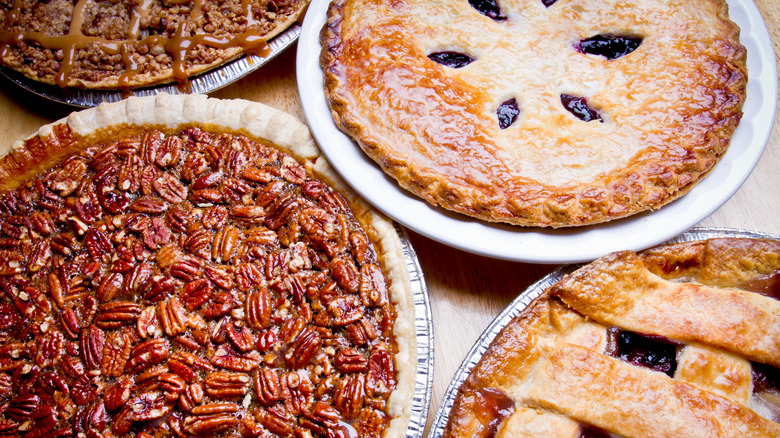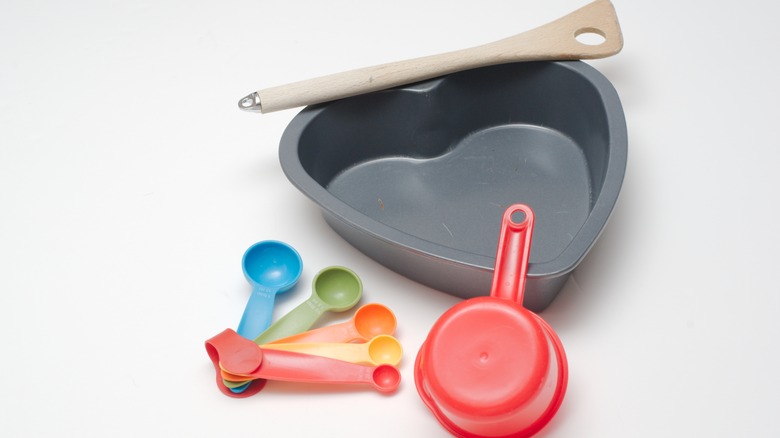Size Matters: The Standard Measurements For Cake Pans And How You Should Adjust
One challenge every baker faces sooner or later is adapting on the fly when the pans a recipe calls for aren't the ones you have on hand. For home bakers, that means you'll need to figure out how to fit your batter into the pans you've got at your disposal. This is a routine calculation for professional bakers, though they come at it from the opposite direction: they'll work backward from the number of cakes they need to the quantity of batter needed and scale the recipe up or down accordingly.
Making the recipe larger or smaller can be complicated for home bakers, so choosing an appropriate pan is usually the easy option. To do that, you'll need to know what the standard measurements are for cake pans and how they relate to each other. I'm a trained chef and sometimes commercial baker, and I have also been a prolific home baker for decades, so I have the background to help you with that. Here's what you need to know.
Round cake pans
The standard round cake pans most recipes call for come in 8- and 9-inch versions, and they're usually 1½ or 2 inches deep. You should never fill cake pans more than ⅔ of the way with batter or half-full for sponge cakes (which rise a little more aggressively), or they may overflow and make a mess.
Since the depth of the batter will be the same regardless of whether it's an 8- or 9-inch pan, you only need to work out its area. For a circle (buckle up, we're going back to geometry class!), you're going to cut the pan's diameter in half to get the radius, multiply the radius by itself, and then multiply that number by pi. It's all coming back to you, right? An 8-inch pan works out to be just over 50 square inches, and a 9-inch pan to 64.
Two 8-inch pans add up to about 100 square inches. Two 9-inch pans total just under 130 inches. If your recipe calls for two 9-inch pans, then three 8-inch pans will hold about the same quantity of batter (it's not exact, but close enough). If the recipe calls for two 8-inch pans and you have 9-inch, you'd need to increase the recipe by about 50 percent.
Square cake pans
Like their round siblings, the most common square cake pans are 8 and 9 inches. Figuring out the area for these is easier because you just have to multiply those numbers by themselves. That gives us 64 square inches for 8-inch square pans and 81 square inches for 9-inch pans. In other words, an 8-inch pan is about ¾ the size of a 9-inch. You could bake an 8-inch recipe in a 9-inch pan, but it will be a thinner layer and would bake more quickly. A 9-inch recipe will over-fill an 8-inch pan, but you can keep back part of the batter to make yourself a cupcake or two on the side as a "chef's treat."
It gets more interesting when you adapt between round and square pans. A 9-inch round and an 8-inch square are the same size and can be substituted for each other. A recipe making two 8-inch rounds will yield one 9-inch square cake, with leftover batter for cupcakes.
You may occasionally encounter oversized round or square cakes. You can apply the same math to those to find out how much of your favorite recipe (or box mix) will be needed to fill them. For these oversized cakes, you might find that a heating core helps them bake evenly.
Rectangular cake pans
Rectangular cake pans for home bakers come in two main sizes: 7x11 inches and 9x13 inches. To work out their area in square inches, simply multiply their length by their width. This gives us an area of 77 square inches for the 7x11 and 117 square inches for the 9x13 cake pan.
A 9x13, then, is about 50 percent larger than a 7x11. If you're making a recipe written for a 9x13 pan in a 7x11, you'll have enough batter left over for cupcakes or even a thin 8-inch round. If you're scaling up a recipe meant for a 7x11 pan, you'll need 1½ batches to fill a 9x13 instead.
If you're converting between rectangular pans and smaller round or square pans, the neatest substitution to know is that a 7x11-inch cake pan (77 square inches) equals a 9-inch square or 1½ 8-inch round pan. Meanwhile, a 9x13-inch cake pan (117 square inches) is equivalent to two 9-inch rounds or two 8-inch squares and is also equal to one and one-half 9-inch square pan.
These aren't exact equivalents, but they're close enough. The differences in pan size won't usually have a meaningful effect on your baking time, but it's always prudent to check before you think your cake should be done: every oven performs differently, especially when the thermometers are unreliable.
Sheet pans
Sheet pans are among the most versatile tools at your disposal, with many uses other than baking. Commercial suppliers list five standard sizes: a full sheet at 18x26 inches, a two-thirds sheet at 16x22 inches, a half-sheet at 13x18, a quarter-sheet at 9½ x 13, and an eighth-sheet at 6½ x 9½. The two-thirds sheet is the largest that will fit in most home ovens, but half-sheets are much more common.
Sizing these, as with rectangular pans, means multiplying their length by their width. For the three sizes you're likely to see in home-baking recipes, that gives us 234 square inches for a half-sheet, 123½ for a quarter-sheet, and 61¾ for an eighth-sheet. Substituting between sheet pans is simple; a half-sheet makes two quarter-sheets or four eighth-sheets, and vice versa (not exactly, but close enough). Most department-store sheet pans are quarter-sheet-sized.
A jelly roll pan (midway between a cake pan and a sheet pan) is 10x15 inches or 150 square inches, so you can use a quarter-sheet as a substitute and have just a little batter left over. A quarter-sheet matches a 9x13 cake pan, so those are direct equivalents. To make a sheet cake from a recipe calling for square or round pans, just multiply the recipe until it matches the size of the sheet pan you plan to use. A half-sheet is about four 9-inch rounds, for example, so you'd double your recipe.
Volume provides another useful measurement for cake pans
Calculating the area of a pan in square inches is a useful way to judge their sizes: for pans small enough or large enough not to show up on your favorite site's conversion charts, it's often the only way to compare. But for common sizes, you may sometimes find it more convenient to adjust by volume.
This is especially useful when you're converting between normal pans and deeper pans, between flat pans and loaf pans, or tube-style pans. You can work out the volume by multiplying the area of a pan by the depth of the batter (two-thirds of its height for most cakes, half-full for sponge cakes) and then dividing by 14.44 (the number of cubic inches in a cup). That takes a bit of "math-ing," but for the most common sizes, you can simply look them up on a chart.
8-inch rounds hold 4 cups (or 6 cups if they're 2 inches deep). 9-inch rounds hold 6 cups (or 8 cups at 2 inches deep). An 8-inch square is the same as a 9-inch round, and a 9-inch square holds 8 cups at 1½ inches' depth (or 10 cups at 2 inches). A rectangular pan at 11x7 also holds 10 cups, and a 13x9 holds 14 cups. With that knowledge in hand, it's easy to work out which size pan to use (or how much to adjust the size of your recipe).
Muffin/cupcake pans
Muffin pans, like loaf pans or Bundt pans, are easiest to work with when we measure in cups rather than working out the cumulative number of square inches in a pan. There are three sizes: standard, jumbo, and mini. A pan may give you as few as six or as many as 24 cups (pro tip: muffin tins have many uses).
The cups of a standard muffin pan have a capacity of 3½ ounces to 3⅘ ounces or almost ½ cup, but — because you need room for your cupcakes to rise — their batter capacity is ¼ cup to ⅓ cup. Mini muffin pans hold about 1½ ounces per cavity or 3 tablespoons, so their batter capacity is 1 to 1½ tablespoons. Jumbos are more variable and can be as small as a 5-ounce capacity to over 8 ounces. The most common size lands at around 7 ounces, or double the capacity of a standard muffin pan (per cup).
A recipe that makes 12 standard muffins or cupcakes will make 6 jumbos. That same recipe can produce up to 36 or 40 minis (you'll get more if your muffins have lots of add-ins). That's also the capacity of a round 8-inch cake pan, approximately 4 cups. A recipe that makes two pans would yield roughly 24 cupcakes.
Bundt pans and tube pans
Bundt and tube pans both form a doughnut shape around a central chimney, which neatly solves the question of how to ensure an evenly baked deep cake. They come in small, medium, and large sizes, typically 7½, 9, and 10 inches in diameter for Bundt pans and 8, 9, and 10 inches for tube pans. Tube pans and the largest Bundt pans are 3 inches deep; smaller Bundt pans are shallower at 2½ inches.
Small, medium, and large tube pans hold 9, 12, and 16 cups of batter, respectively. With Bundt pans, it's 6, 9, and 12 cups (Bundt pans are tapered and patterned, which reduces their capacity). Medium and large Bundt pans correspond to the small and medium tube pans. Remember that 8 and 9-inch rounds hold 4 and 6 cups, respectively, so a recipe that makes 2 layers should fit (respectively) a medium or large Bundt.
It's important to note that while a recipe meant for a Bundt pan can bake in the corresponding tube pan, the opposite isn't always true. Some types of batter aren't "Bundt-friendly" because they'll tear when you try to unmold them.
Character and other specialty pans
When kid birthdays roll around, you may find yourself frantically figuring out how to meet your youngster's request for a cake in the shape of a specific, well-loved character from a cartoon, movie, or TV show. Manufacturers like Wilton have your back with a catalog of pans in character shapes (believe us when we tell you it's easier than sculpting one from scratch!).
For convenience, most of these special-purpose cake pans are sized to hold a standard box-mix cake, which would otherwise make a 9x13 cake pan. A few require two boxes.
If you're a scratch baker, you can treat these special-character pans as a 9x13 for conversion purposes. A recipe sized for a 9x13, two 9-inch round pans, or two 8-inch square pans should do the job, but if the pan looks larger or deeper than most, you might opt to scale up the recipe or make a second batch. Any surplus batter can go to cupcakes.
Springform pans
If you've ever scraped and cussed while coaxing a stuck-on cake out of a pan, then you'll understand why springform pans are a godsend. It's much easier to loosen the sides of a springform and lift out your cake on the removable bottom.
Springforms come in a range of sizes, with 9- and 10-inch pans the most common. You'll also see smaller 6- and 8-inch pans, used mostly for cheesecakes, and occasionally a square or a 9x13 springform, though they're harder to find. A 9-inch springform holds 10 cups of batter, a 10-inch holds 12, but you can also fit 12 cups into a 9-inch springform if it's extra-deep, meaning 3 inches or more.
A recipe that calls for two 9-inch round pans can be baked in a 10-inch springform or a deep 9-inch. A recipe that calls for two 8-inch round pans can be baked in a 9-inch springform. A recipe meant for a conventional 9x13 cake pan can fit a 10-inch springform. In each case, the cake will need to bake longer because of the pan's depth, and you'll usually need to turn down the heat by at least 25 degrees Fahrenheit so the edges won't overbake.
Loaf pans
Most loaf pans fall into three standard sizes: 8x4, 8½x4½, and 9x5. A standard bread pan is the middle size, which will bake a 1-pound loaf. The larger 9x5 can bake a loaf using 3½ to 4 cups of flour, again depending on the type of loaf.
The smaller 8x4 size is typically used for loaf cakes rather than bread and holds the same 4 cups of batter as an 8-inch round cake pan. The middle size holds 6 cups, and the larger 9x5 holds 8. If you're switching between loaf cakes and conventional cakes, you can substitute an 8x4 for an 8-inch round, an 8½x4 ½ for a 9-inch round, and a 9x5 for two 8-inch rounds.
You may also have mini loaf pans, usually measuring 5¾x3 ¼ or 5⅝x3 ⅛. These make a ⅜ pound loaf, about 40 percent of a standard 8½-inch bread pan's capacity, or up to 1½ cups of batter. Finally, serious bread bakers might own a so-called Pullman loaf pan. These are longer, at 9 or 13 inches, and are 4 inches wide and high. They have a lid, and they're meant for baking square sandwich bread. A 9-inch Pullman pan holds as much dough as a 9x5 loaf pan, and a 10-inch will hold as much dough as two standard pans
Tart and quiche pans
If you've mastered a pie crust (or at least mastered buying them), you can make a tart or quiche just as easily. Tart pans are shallow, usually an inch deep and most are 9¼ or 11 inches in diameter. Quiche pans are deeper, at 1¾ to 2 inches, and are usually in 9- and 10-inch diameters. You may find the deeper pans also labeled as tart pans, though it's quiches that really benefit from the extra depth.
For these, like round cake pans, it's the physical area of the pan that matters, and the math is the same. Pans at 9 inches' diameter check in at just under 64 square inches, 9¼-inch pans at about 67, 10-inch pans at 78½, and 11-inch pans at 95. To make a quiche in a 10-inch pan rather than a 9-inch, then, you'd need about 25 percent more crust and filling. Going the other way you can cut back your recipe by about 15 percent or cook the extra filling as homemade egg bites.
With tarts, if you're scaling up from the smaller pan to the large 11-inch version, you'll need to increase your recipe by about half. Going the other way, reduce it by ⅓ or use the excess pastry and filling to make individual tartlets. For larger or smaller tart pans, the same simple math applies, though the smaller your pan, the more pastry you'll need relative to the amount of filling.
Pie pans, aka pie plates
A quick visit to a bakers' supply website will show pie pans in sizes up to 12 inches, but the standard-sized ones you find at department stores are most often 8, 9, or 10 inches. Modern recipes are typically written for a 9-inch pie plate, but family recipes are unpredictable. Unless you inherited her own pie plate, you'll have to play it by ear.
To complicate things further, some pie pans are deeper than the standard 1 inch, and their actual diameter can vary significantly from one manufacturer to another. Your best bet is to measure the real diameter of your pan with a measuring tape, and then do the math to see how it compares to the 64 or 78 square inches of standard 9-and 10-inch pans. You can increase or decrease your recipe accordingly.
If math makes your head hurt, don't worry: adapting your plans to match your pan size is a relatively low-stakes game with pies. Fruit pies can simply be piled higher, and with custard pies, you can pinch up your pastry to make a high rim to contain any extra filling. When all else fails, you can also pour any surplus into ramekins and make individual custards. Other factors have a bigger impact, like your choice of material (many experts prefer metal pie tins).
Measuring non-standard pans
Some pans don't fit neatly into these standard categories. Think heart-shaped Valentine's pans, oversized and undersized pans, or vintage pans that may not conform to modern-day standards. To work with those, you'll need to get hands-on and measure them directly.
The simplest way to do this is to fill the pan to an appropriate depth with water or a dry ingredient, like sugar — ⅔ full for most cakes, ½ for sponge cakes. Pour that out into one or more large measuring cups, and that tells you the pan's volume.
If you don't have large measuring cups, you can work with a 1-cup measuring cup and start from the opposite direction: carefully measure 1 cup at a time and pour it into your pan until it reaches the right depth. Write this down for the next time you use that same pan. It's also helpful to make a note of which conventional pan size it corresponds to, so the next time you want to use it, you'll know which size of recipe is appropriate.
